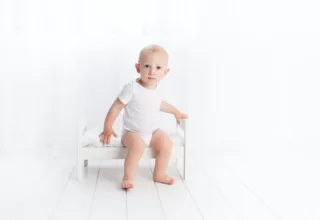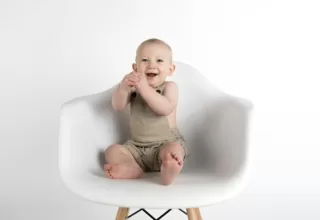What Should I Do If My Baby Resists Potty Training?
Outline
- Introduction
- Understanding the reasons behind resistance
- Creating a positive environment
- Patience and consistency.
- Adjusting the approach
- Making it fun and engaging
- Addressing setbacks and challenges
- Seeking professional advice
- Conclusion
- FAQs
Potty training is an important milestone in a child’s development, but it can sometimes be met with resistance. If you find yourself facing a situation where your baby resists potty training, it’s essential to approach it with patience, understanding, and adaptability. In this article, we will explore effective strategies to overcome this challenge and help your baby transition successfully from diapers to using the potty.
Introduction
Introduce the topic of potty training and its importance. Address the common issue of baby resistance in potty training. Potty training is a significant step in your baby’s journey towards independence and self-care. It empowers them to develop a sense of control and responsibility over their bodily functions. However, it’s not uncommon for babies to resist this transition, leading to frustration for both parents and child. By understanding the reasons behind their resistance and implementing the right approach, you can navigate this phase successfully and ensure a smooth potty training experience.
Understanding the Reasons Behind Resistance
Highlight the various factors that can contribute to baby resistance. Discuss the role of fear and anxiety in potty training. Baby resistance in potty training can stem from a variety of reasons. Some babies may feel fear or anxiety associated with the unfamiliarity of using a potty or the pressure to perform. Others might be comfortable with their current routine and reluctant to change. Identifying the underlying cause of their resistance is crucial in developing a targeted approach to overcome it.
Creating a Positive Environment
Creating a positive environment is essential to encourage your baby during potty training. By providing a supportive and encouraging atmosphere, you can help them feel more comfortable and motivated to embrace the process. Here are some tips for setting up a child-friendly potty training environment:
- Choose the right potty seat: Invest in a potty seat that is comfortable and age-appropriate for your baby. Opt for seats with backrests and handles for added support. Let your baby choose their potty seat to create a sense of ownership.
- Make it accessible: Ensure the potty seat is easily accessible for your baby. Place it in a convenient location, such as the bathroom, and encourage your baby to sit on it regularly, even if they’re not using it yet.
- Use visual aids: Introduce books or videos about potty training to familiarize your baby with the process. Visual aids can help them understand and visualize what to expect.
- Celebrate small victories: Praise and reward your baby for their efforts, even if they haven’t fully mastered potty training yet. Celebrate each small step they take towards success to build their confidence and motivation.
Patience and Consistency
Stressing the significance of patience during the potty training process is crucial. Remember that every child is different, and progress may vary. Here’s why patience and consistency are key:
- Set realistic expectations: Understand that potty training is a gradual process that takes time. Avoid putting pressure on your baby or yourself to achieve quick results. Instead, focus on the journey and celebrate every milestone.
- Establish a routine: Consistency is key when it comes to potty training. Create a regular schedule for potty breaks and stick to it. This consistency helps your baby develop a sense of predictability and understand the expectations.
- Be calm and supportive: Stay calm and patient during accidents or setbacks. Avoid scolding or punishing your baby, as this can create anxiety and hinder their progress. Offer reassurance and guidance, emphasizing that accidents are part of the learning process.
- Model behavior: Let your baby observe and learn from your own bathroom habits. When appropriate, explain what you’re doing and why. Modeling positive behavior can help normalize potty training and make it less intimidating for your baby.
Adjusting the Approach
Discuss the need to adapt the potty training method to the baby’s personality and preferences. Provide different strategies and techniques for overcoming resistance. It’s important to recognize that not all potty training methods work for every child. Each baby has their own unique personality and preferences, so adapting the approach is essential. Here are some strategies and techniques to consider:
- Choose the right method: Explore different potty training methods, such as the gradual approach or the three-day method. Assess your baby’s temperament and choose the method that aligns with their needs and comfort level.
- Offer choices: Give your baby a sense of control by offering choices. For example, let them pick their potty seat, underwear, or even the time they want to sit on the potty. This empowerment can help reduce resistance and increase cooperation.
- Use positive reinforcement: Motivate your baby by using positive reinforcement techniques. Offer verbal praise, high-fives, or small rewards, such as stickers or a favorite activity, when they make progress or successfully use the potty. This positive reinforcement reinforces their efforts and encourages continued success.
- Introduce role-playing: Engage in pretend play where your baby can practice potty training with their favorite toys or dolls. This interactive and imaginative approach can make the process more enjoyable and less intimidating.
- Use storytelling: Create a story or a character that your baby can relate to and incorporate potty training into the narrative. This storytelling approach can make the process more engaging and relatable for your baby.
- Incorporate music and songs: Introduce fun and catchy songs about potty training. Sing them together during potty breaks to make the experience more enjoyable and entertaining.
Making it Fun and Engaging
Suggest creative ways to make potty training enjoyable for the baby. Highlight the effectiveness of positive reinforcement and rewards.
Making potty training fun and engaging can motivate your baby and make the process more enjoyable for both of you. Here are some ideas to add a touch of excitement to the potty training journey:
- Use potty training charts: Create a colorful and personalized potty training chart to track your baby’s progress. Let them add stickers or stamps to mark each successful trip to the potty. This visual representation of their achievements can be highly motivating.
- Play games: Introduce potty-related games or activities to keep your baby engaged. For example, use floating toys in the toilet bowl and encourage your baby to aim at them while urinating. This playful approach can make the process more interactive and enjoyable.
- Read potty-themed books: Incorporate potty training books into your reading routine. There are numerous children’s books available that focus on potty training, using engaging stories and colorful illustrations to capture your baby’s interest.
- Use fun and colorful underwear: Transitioning from diapers to underwear can be exciting for your baby. Let them choose their favorite character-themed or colorful underwear, making them eager to wear them and avoid accidents.
- Celebrate milestones: Set mini-goals along the potty training journey and celebrate each achievement. For example, when your baby successfully uses the potty independently or stays dry throughout the day, commemorate the occasion with a special treat or activity.
Addressing Setbacks and Challenges
Acknowledge that setbacks are common and part of the learning process. Offer guidance on how to handle regression and difficulties during potty training. It’s important to understand that setbacks and challenges are normal during potty training. Patience and perseverance are key in overcoming these obstacles. Here’s how to address setbacks effectively:
- Stay calm and supportive: If your baby experiences setbacks or regresses in their potty training progress, remain calm and supportive. Reassure them that accidents happen and that they’re doing a great job overall.
- Identify triggers: Pay attention to any triggers that may be causing resistance or setbacks. It could be changes in routine, stress, or specific situations. By identifying these triggers, you can proactively address them and provide extra support during challenging times.
- Revisit the basics: During setbacks, it can be helpful to take a step back and review the basics of potty training. Reinforce the importance of regular potty breaks, using positive reinforcement, and maintaining consistency in routines.
- Offer comfort and reassurance: If your baby expresses fear or discomfort during potty training, offer comfort and reassurance. Talk to them about their concerns, address any misconceptions, and provide gentle encouragement to help them overcome their fears.
Seeking Professional Advice
Persistent resistance in potty training that lasts for an extended period despite your best efforts may warrant professional guidance. If you’ve tried various strategies and techniques without seeing progress, it’s advisable to consult with a pediatrician or child development expert. They can provide valuable insights, assess any underlying issues, and offer tailored recommendations specific to your baby’s needs.
- Developmental concerns: If you notice other developmental delays or challenges alongside potty training resistance, it’s important to seek professional evaluation. A child development expert can assess your baby’s overall development and determine if there are any underlying factors contributing to the resistance.
- Emotional or behavioral difficulties: In some cases, potty training resistance may be linked to underlying emotional or behavioral difficulties. If you observe persistent anxiety, extreme fear, or behavioral changes that significantly impact the potty training process, it’s essential to seek professional advice to address these concerns effectively.
Remember, seeking professional advice doesn’t necessarily mean there’s a serious problem. It’s a proactive step to ensure your baby receives the necessary support and intervention if needed.
Conclusion
Recap the main points discussed in the article. Reiterate the importance of patience, consistency, and creating a positive environment for successful potty training. Potty training resistance can be challenging for both parents and babies, but with the right approach, it can be overcome successfully. Throughout this article, we’ve explored strategies to help you navigate this phase. Remember the following key points:
- Understand the reasons behind resistance and address any fears or anxieties.
- Create a positive and supportive environment to make potty training comfortable and enjoyable.
- Practice patience and consistency, setting realistic expectations for your baby’s progress.
- Adapt the approach based on your baby’s personality and preferences, using positive reinforcement.
- Make potty training fun and engaging through games, books, and celebratory milestones.
- Address setbacks and challenges with reassurance, revisiting the basics if necessary.
- Seek professional advice if resistance persists or if there are developmental or emotional concerns.
By approaching potty training with patience, understanding, and adaptability, you can support your baby in successfully mastering this important milestone.
FAQs
How long does potty training typically take?
Potty training duration varies for each child. It can take a few weeks to several months to achieve consistent success. Patience and consistency are key during this process.
Is it normal for a baby to resist potty training?
Yes, it’s normal for babies to resist potty training. Each child is unique, and resistance can be influenced by various factors such as fear, anxiety, or a preference for their current routine.
Can I start potty training if my baby shows resistance?
Yes, you can start potty training even if your baby initially resists. Be patient, create a positive environment, and adapt your approach based on their needs and preferences.
What if my baby only wants to use diapers and refuses the potty?
If your baby refuses the potty and insists on using diapers, gently encourage and gradually transition them by using positive reinforcement, making potty time fun, and setting consistent routines.
Are there any specific signs that indicate my baby is ready for potty training?
Signs that your baby may be ready for potty training include showing interest in the bathroom, communicating their needs, staying dry for longer periods, and being able to follow simple instructions.
How useful was this post?
Click on a star to rate it!
Average rating 0 / 5. Vote count: 0
No votes so far! Be the first to rate this post.



